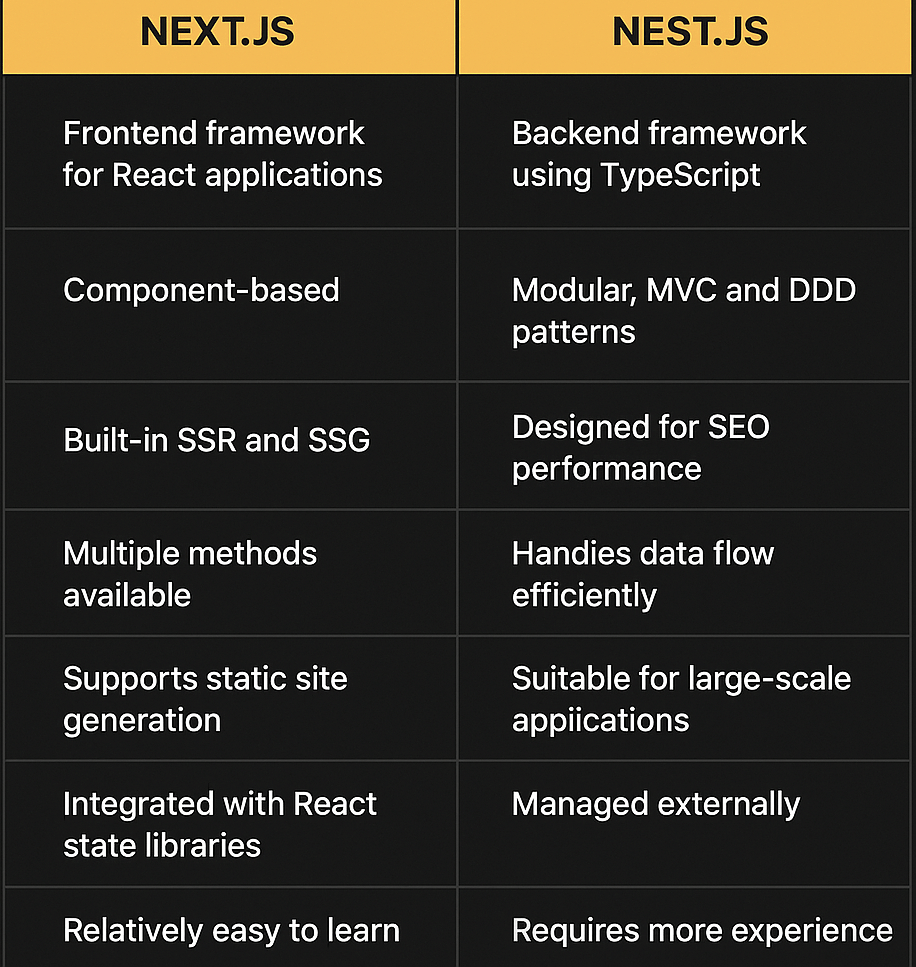What’s the Difference Between Next.js and Nest.js, and Which Should You Choose?
The web development landscape demands flexible, high-performance frameworks. When comparing Next.js and Nest.js, the choice comes down to your project's focus: frontend user experience or backend scalability.
What is Next.js?
Next.js is a React-based framework by Vercel that empowers developers to build fast, scalable, and SEO-optimized web applications. Its key strengths include:
- Server-Side Rendering (SSR) and Static Site Generation (SSG)
- App Router using React Server Components
- Automatic Code Splitting to reduce load times
- Optimized Image Handling via the
next/imagecomponent - Edge Functions & Middleware for improved performance and security
- Built-in API Routes for full-stack capabilities
Ideal for dynamic websites, content-rich pages, and high-performance SaaS frontends.
What is Nest.js?
Nest.js is a progressive Node.js framework written in TypeScript. Inspired by Angular’s architecture, it offers structure and scalability for building robust backends. Core features include:
- TypeScript-first approach for type safety
- Modular Architecture for maintainable code
- Built-in Dependency Injection
- Support for REST, GraphQL, WebSockets, and Microservices
- Authentication & Authorization mechanisms
Perfect for enterprise applications, real-time services, and scalable APIs.
Key Differences Between Next.js and Nest.js

Performance and Scalability
- Next.js excels at delivering fast frontends with minimal latency using modern rendering techniques.
- Nest.js handles large-scale backend loads, supporting microservices and real-time communication out of the box.
Security and Maintenance
Both frameworks are actively maintained and well-documented.
- Next.js provides route protection and edge middleware.
- Nest.js integrates with
Passport.jsand offers guards and secure database layers.
When to Choose Each
Choose Next.js if:
- You’re building a performant, SEO-friendly web application.
- Your focus is on frontend UX and developer experience.
- You need hybrid rendering (SSR/SSG) with built-in backend routes.
Choose Nest.js if:
- You require a structured, scalable backend for APIs.
- Your app needs GraphQL, WebSockets, or microservices.
- You’re building enterprise-grade systems or real-time apps.
Conclusion
Both Next.js and Nest.js are powerful tools. For frontend-focused projects, choose Next.js. For backend-heavy systems, Nest.js is a clear winner. Used together, they create a full-stack powerhouse for any modern web application.
FAQs
Can I use Next.js and Nest.js together?
Yes! Many teams combine them to create full-stack applications, leveraging Next.js for the frontend and Nest.js for a robust backend.
Which is better for SEO?
Next.js. It offers SSR and SSG, boosting search engine visibility.
Is Next.js good for SaaS?
Absolutely. Its speed, scalability, and SEO optimization make it ideal for SaaS apps.
Does Nest.js support GraphQL?
Yes, with built-in support and TypeScript tooling for scalable GraphQL APIs.